
Memory studies
Facets of memory
Memory is Malleable—Loftus & Palmer (1974)\
About how fast was the car going when it ________ the stopped car?
the wording of the question influenced the memory
Misconceptions of Memory: The Scooter Libby Effect—Kassam, Gilbert, Swencionis, & Wilson (2009)
Vice-Presidential Chief of Staff I. Lewis “Scooter” Libby claimed that he could not remember mentioning the identity of a Central Intelligence Agency employee to other government officials or reporters. Jurors found it difficult to believe that Libby could have forgotten having had such important conversations and found him guilty of obstruction of justice, making false statements, and perjury.
motivation to remember (MTR)
Participants were shown photographs of six individuals ostensibly taken from a high-school yearbook. Each photograph was accompanied by five facts (e.g., “John Smith enjoyed playing sports with his friends” or “Sarah Palmer spent a lot of time tutoring her younger brother”).
Memorizers were told that they would study the material for 2 min before seeing the photographs and trying to recall the facts associated with each. They were also told that they would receive $0.10 for each recalled fact.
Judges were shown the same material as memorizers and read a detailed description of the instructions from the MTR-at-encoding condition (n = 24), the MTR-at-retrieval condition (n = 21), or the no-MTR condition (n = 21). Judges were then asked to predict the percentage of memorizers in that condition who would remember each fact.
Our study shows that people mistakenly expect MTR to be just as effective when it arises after information is encountered as when it arises beforehand. Thus, they sometimes expect others to remember more than they possibly can.
The study found that memorizers recalled more facts when motivated before reading than after, with post-reading motivation no better than no motivation. However, judges incorrectly expected both pre- and post-reading motivation to enhance memory equally and outperformed no motivation. This reveals a gap between actual memory performance and judges' expectations.
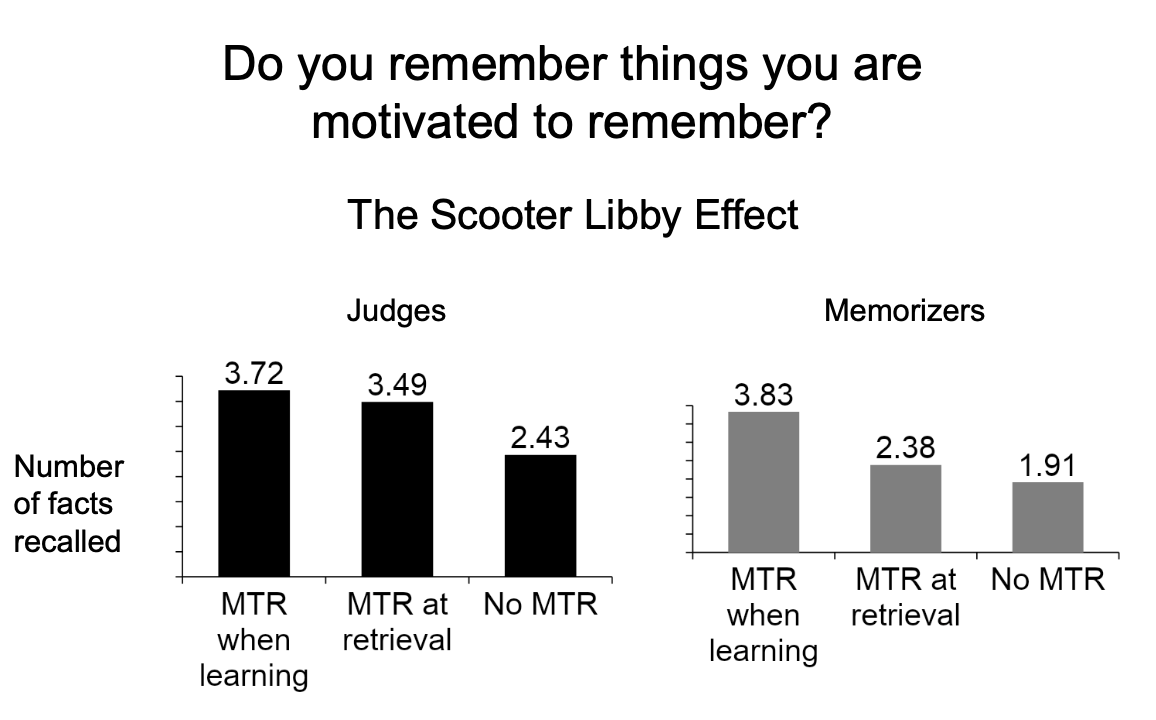
Memory works in ways we don’t realize—Simons & Chabris (2011)
This discrepancy between popular belief and scientific consensus has implications from the classroom to the courtroom.
Amnesia results in the inability to remember one's own identity (83% of respondents agreed), unexpected objects generally grab attention (78%), memory works like a video camera (63%), memory can be enhanced through hypnosis (55%), memory is permanent (48%), and the testimony of a single confident eyewitness should be enough to convict a criminal defendant (37%
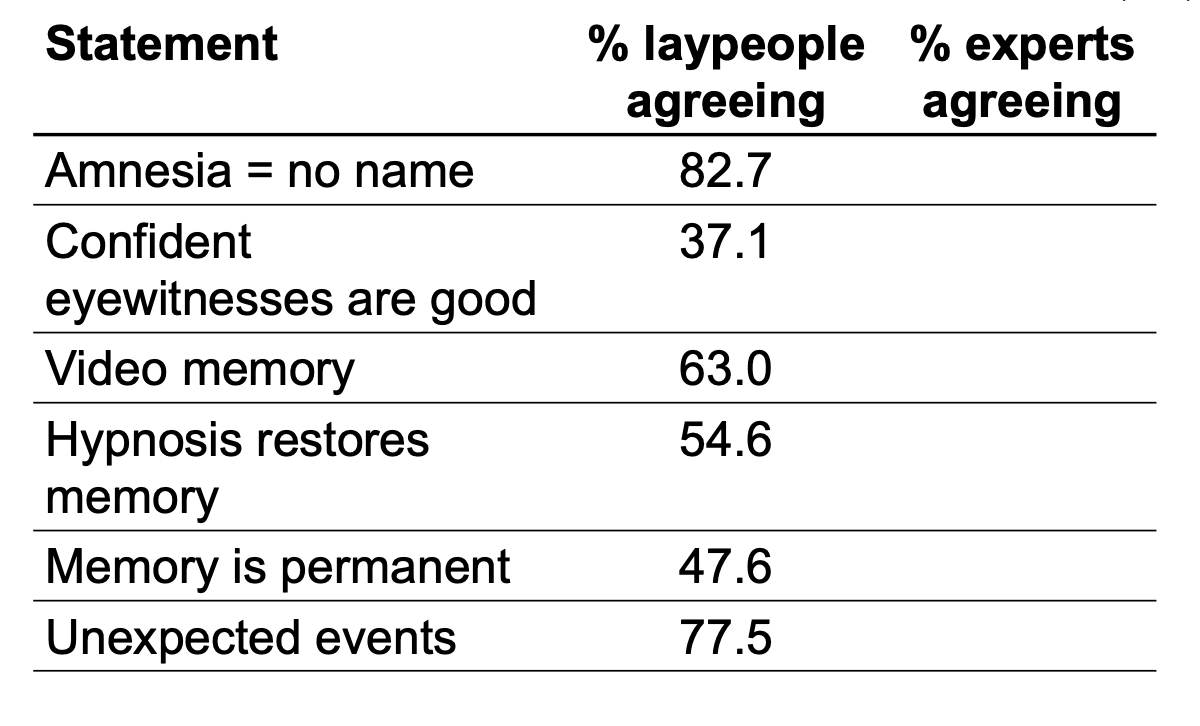
Models of Memory
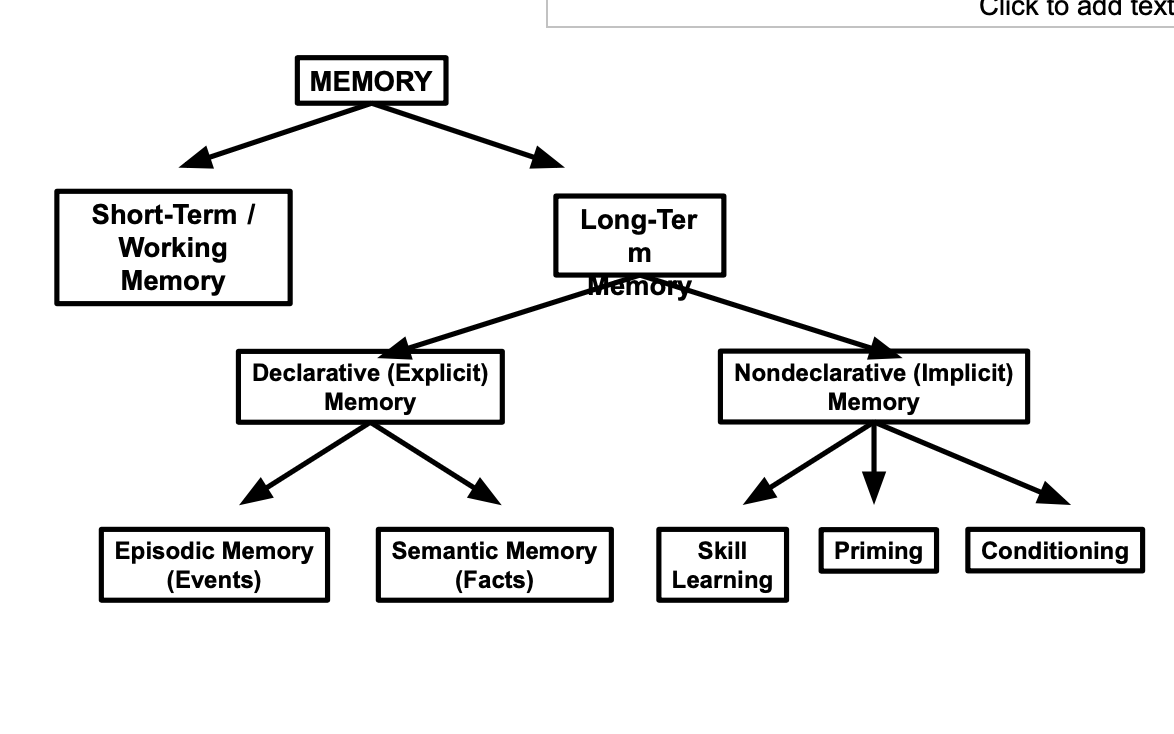
Modal Model of Memory—Atkinson & Shiffrin (1968)
Memory has 3 components
sensory memory— iconic, echoic, haptic
working memory / short-term memory— capacity for holding a small amt of info for a short period of time
7 ± 2
20-30 sec
long-term memory

Sensory Memory
In each trial:
Read a 3-letter string (e.g., TRQ)
Read a 3-digit number (e.g., 555)
Count backwards by threes (silently)
E.g., for 555, count 552, 549, 546…
When the word “stop” appears 🡪 write down the 3-letters
Look to the left column to read the next string
Classic Test of Sensory Memory (Iconic)—Sperling (1960)
participants were briefly shown a grid of 12 letters for 50 milliseconds then were asked to recall as many letters as they could
could initially only remember 3-4 letters
then changed conditions to be high, medium, then low tone for each row
participants could remember all of them after
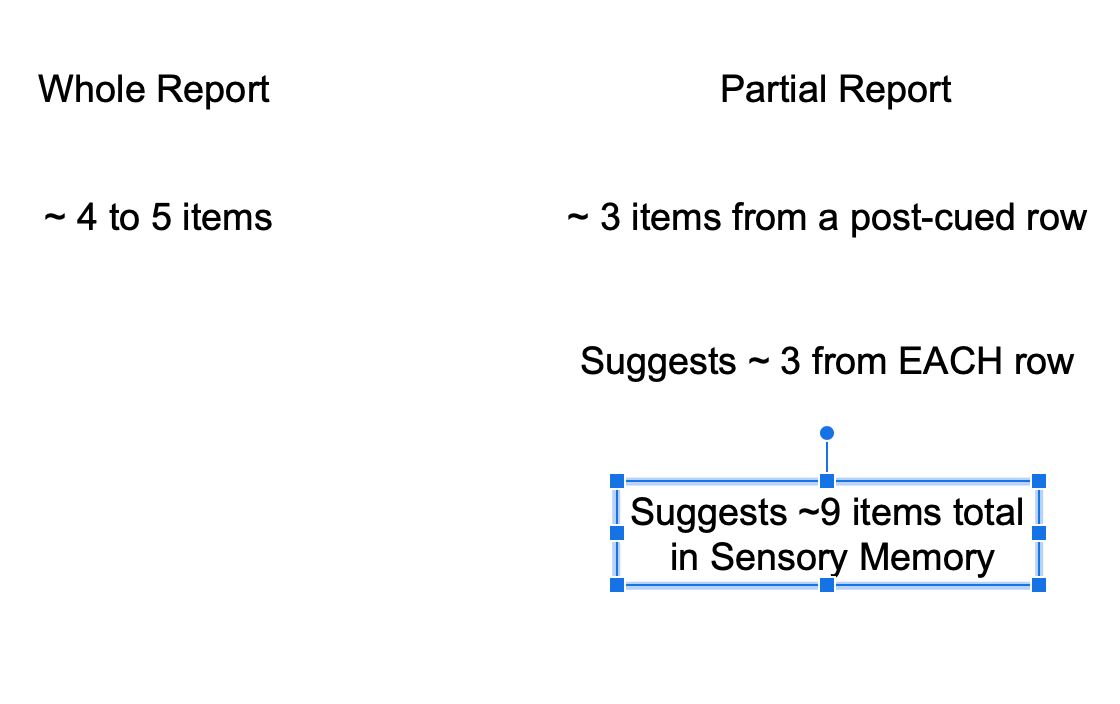


Hierarchical Structure of Semantic Networks, Collins & Quillian (1969)
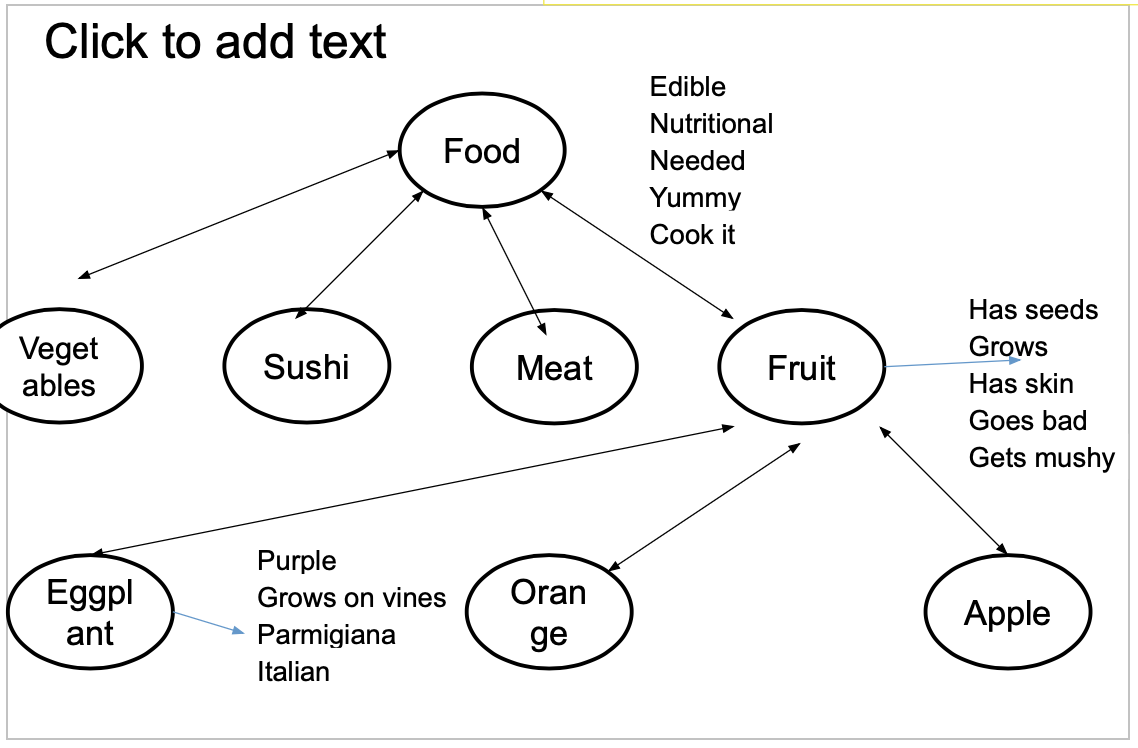
“is an eggplant food/fruit/rggplant”
looked at speed, as you move up the hierarchy speed of answer slows down
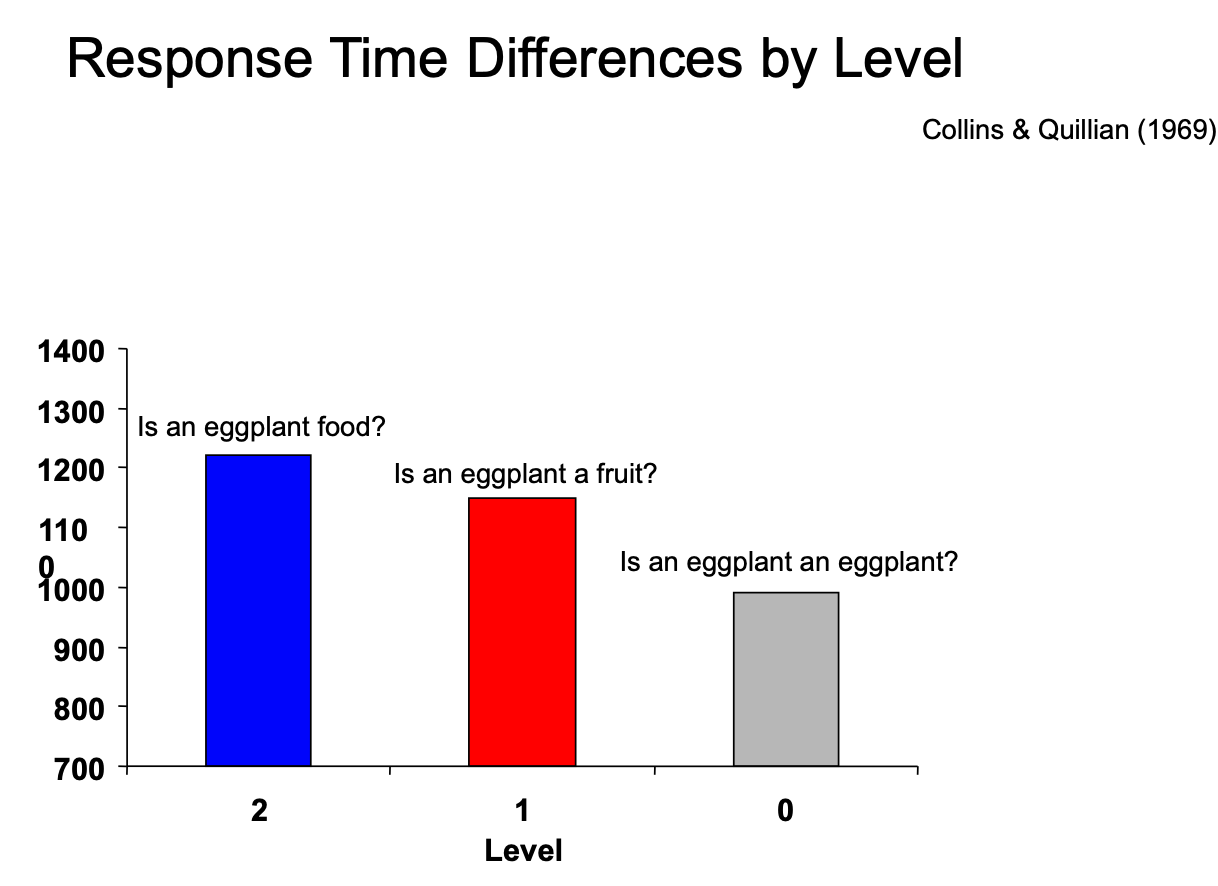
ex. talking about something that is related to something that someone else brought up, moving up the semantic bridge
the more connections you have, the more you’ve woven it into the semantic network, the more activation of the network
Working Memory— primacy and recency
What causes Primacy & Recency Effects?
Primacy – Extended rehearsal moves info to long-term memory
longterm interferes with working
Recency – Recent rehearsal keeps info in working memory at test
short term/working intereferes with long term
Primacy and Recency Effects reveal different operations involved with Working Memory

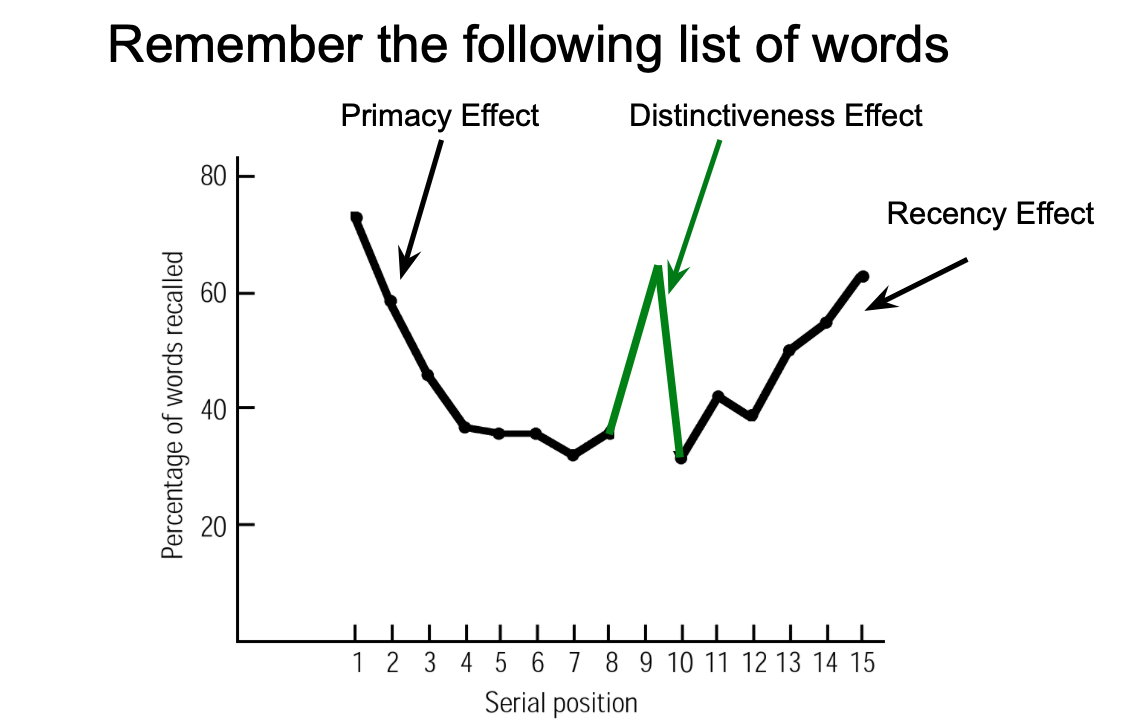
Baddeley’s Model of Working Memory—Baddeley (1974)
phonological loop—auditory part of working memory; being used when saying things to yourself or listening to others
evidence: Working memory affected by Word Length
evidence: Working memory affected by Reading Speed
evidence: Working memory affected by Language
visuospatial sketch pad—picture things in working memory and work on them
mental maps etc
episodic buffer— part of working memory that temporarily stores info brought up from long-term memory
central executive— controls how attention to paid to each of other parts of working memory, brings info from long-term memory, and puts things together
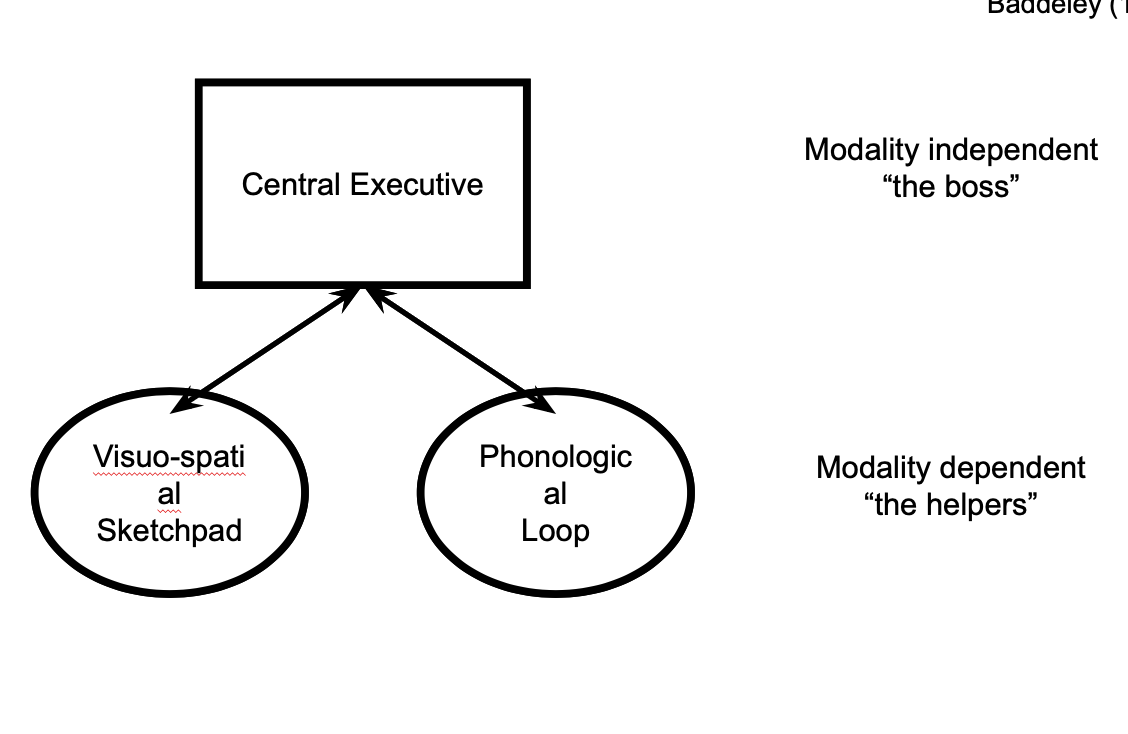
Object-based Working Memory (how is info stored in visuospatial sketchpad?) —Luck & Vogel (1997)
Main Claims
Visual information stored as objects
Limit of about 3-4 objects
If you remember one feature of an object, you get all the other features for free
Change Detection Paradigm:
The study used a change detection paradigm where participants viewed a set of objects with different features (like color and shape) and then had to identify if a single feature on one of the objects had changed in a subsequent display.
found No change in accuracy for 3-4 objects (remembered them fine, but more than that found a decrease in performance) —>limited
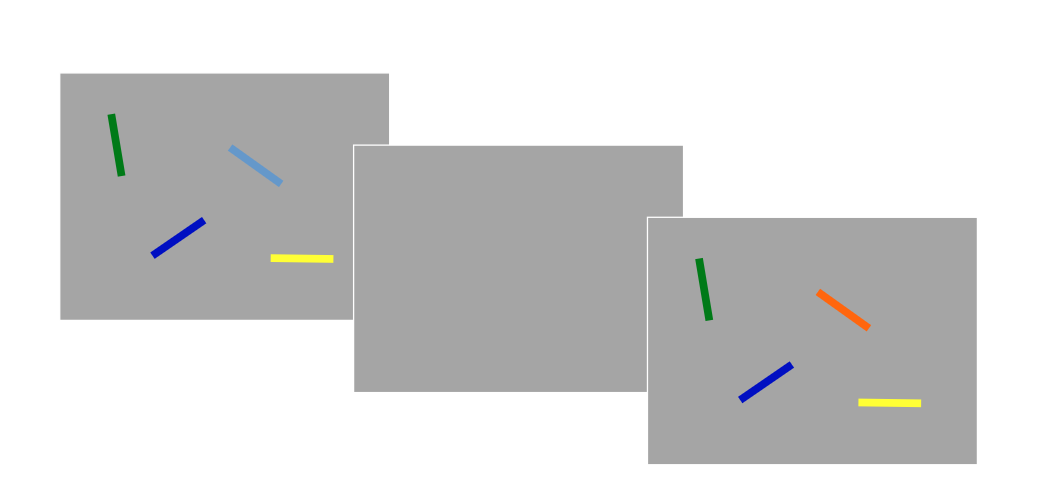
Conjunctions
Remember Orientation (ignore color)
Remember Color (ignore orientation)
Remember Orientation & Color
Findings: Consistent with object-based! —> features don’t matter, just how many there are as integrated objects (culmination of features)
Object Benefit:
The key finding was that participants were able to accurately detect changes in a set of objects with multiple features, even when the number of features increased, as long as those features belonged to the same object. This "object benefit" indicated that the brain stores objects as unified entities rather than individual features.
Implications:
This research significantly contributed to the understanding of visual working memory, suggesting that the capacity of visual working memory is not limited by the number of individual features but rather by the number of distinct objects that can be held in memory
Potential problems with object based working memory— Alvarez & Cavanagh (2004)
, both the visual information load and number of objects impose capacity limits on visual short-term memory.
The greater the information load of each item in a stimulus class (as indicated by a slower search rate), the fewer items from that class one can hold in memory.
Extrapolating this linear relationship reveals that there is also an upper bound on capacity of approximately four or five objects.
Updated model of Baddledy’s model
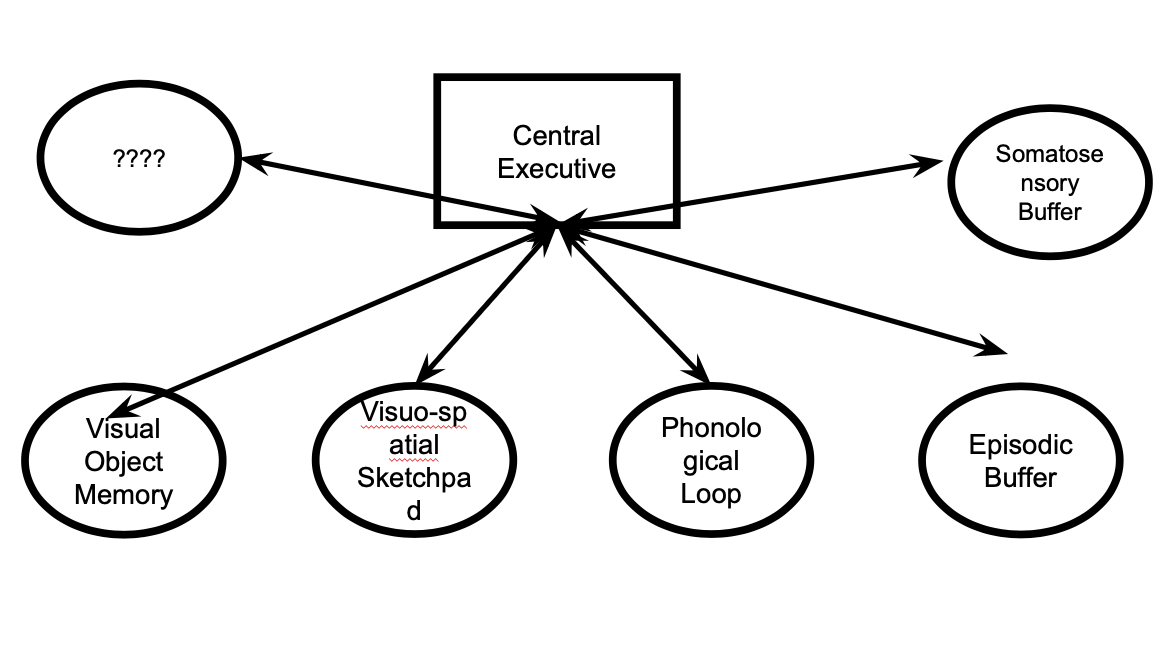
Memory processes
Interference
Proactive Interference: An item you learned previously affects something you’re trying to recall recently
Retroactive Interference: learning something after the first interferes with recalling the initial information
Interference shows that putting new things into long-term memory affects other things that are there, and vice versa.
General point that our memories are connected.
the more similar the contents are, the greater chance of interference
Encoding and retrieval
Encoding: Acquiring information and transferring it into LTM
retrieval: Recovering previously encoded information
the more organized your encoding structure, the better you’ll remember it
Elaboration: Making additions to the target item
makes connections in semantic memory
E.g., remember “table”
Tables are types of furniture
Furniture is very expensive
I buy furniture in IKEA because it is more reasonably priced
Last year I bought a great table in IKEA
Depth of processing Craik & Tulving (1975)
Orthographic: what does the word look like (capital/lowercase)
Phonological: how does the word sound
Semantic: what is the meaning of the word
the deeper you process it initially, the better you remember it
Elaboration
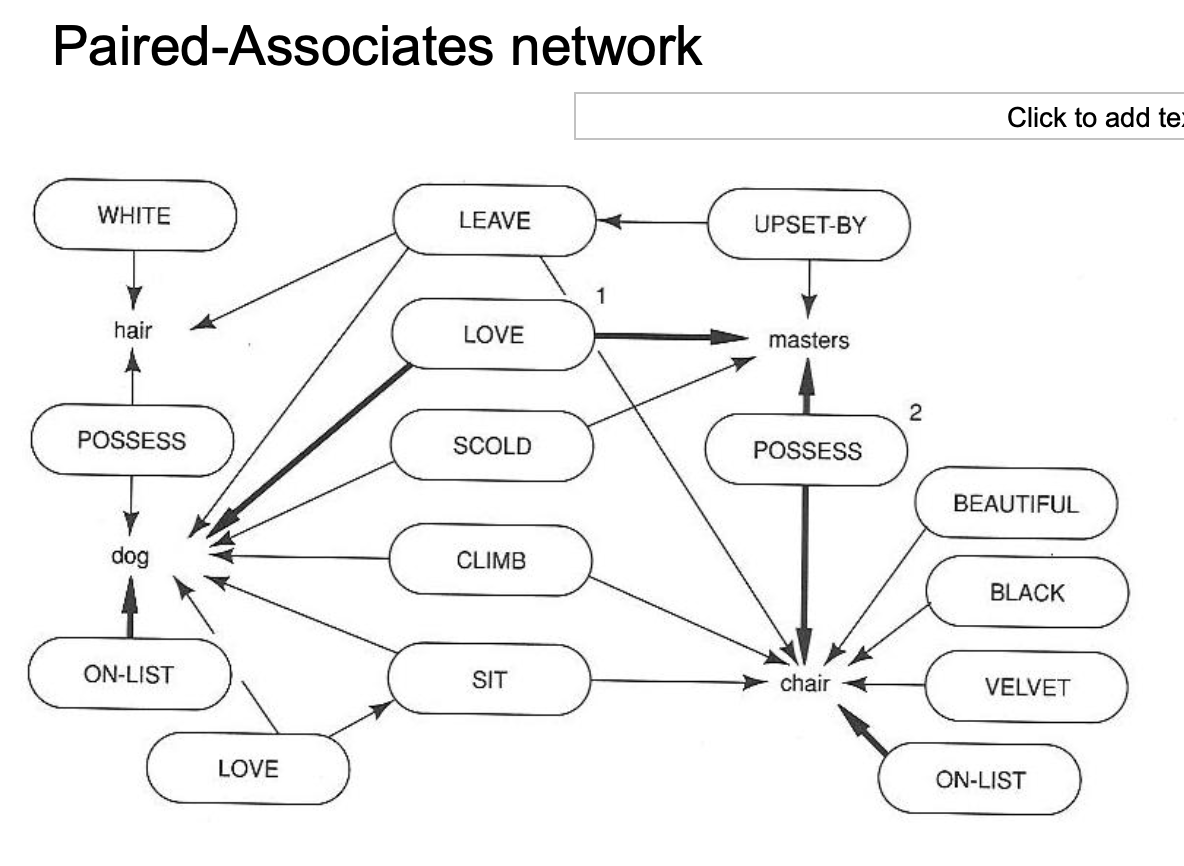
Location dependent memory—Godden & Baddeley (1975)
group of subjects in a pool or on land in scuba gear
reading them a list of words that they need to learn either on land or in water
Half recall on land, half recall in water
learned on land recalled better on land
learned underwater recalled better on land
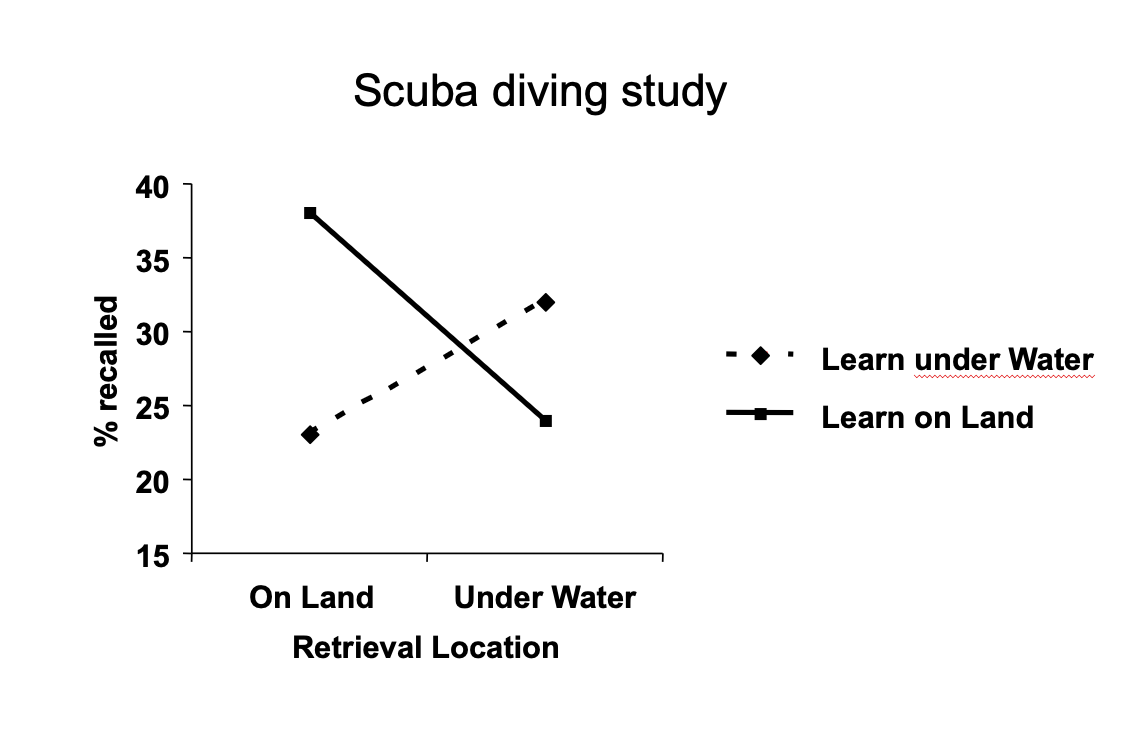
Emotion Dependent Memory—Bower (1981)
induced emotion to be happy or sad
then learned a list of words
then made them recall a list of words and asked if it made them happy or sad
if youre happy when you learn and happy when you retrieve, then you remember more

State Dependent Memory—Rickles, Cohen, Whitaker, & McIntyre (1973)
needed multiple trials with marijuana
when you learn intoxicated, you’re better at recalling when you’re intoxicated
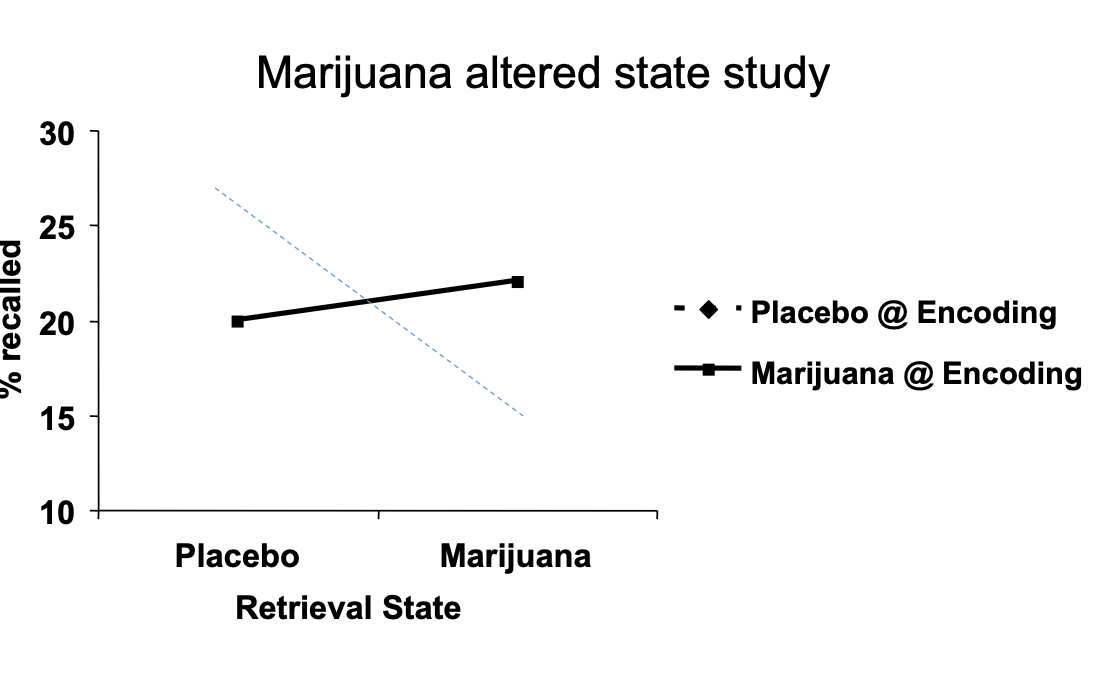
Effects of Spacing on Memory—Bahrick, Bahrick, Bahrick, & Bahrick (1993)*
gave subjects foreign language words, and had no relation
tested retention of foreign language of fpreign language vocabulati words
After Learning, tested 1, 2, 3, & 5 years later
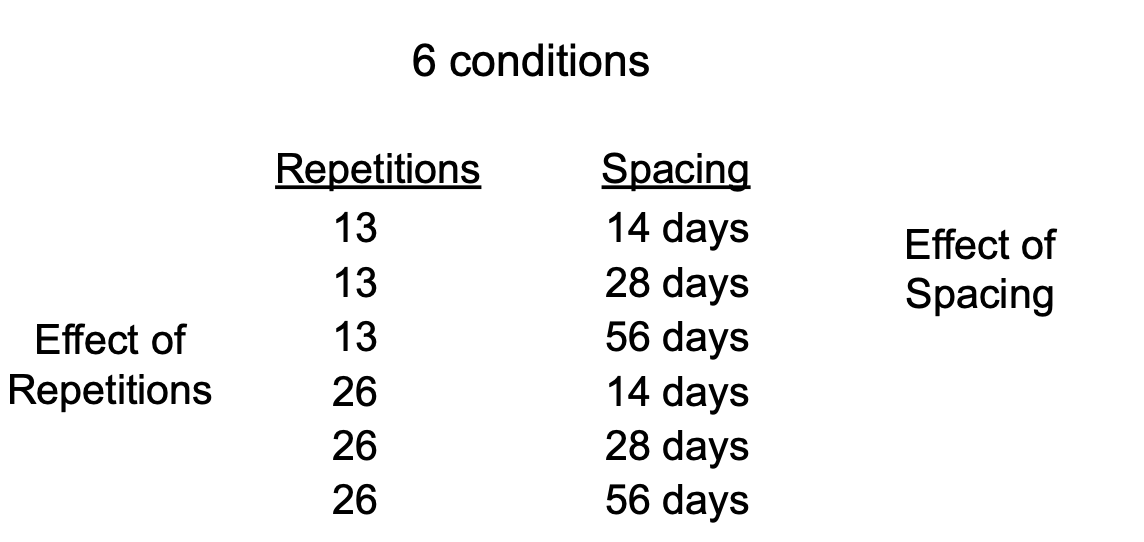
long term implications
Findings: best retentions comes with spacing learning
more times more recall
more space had a better recall
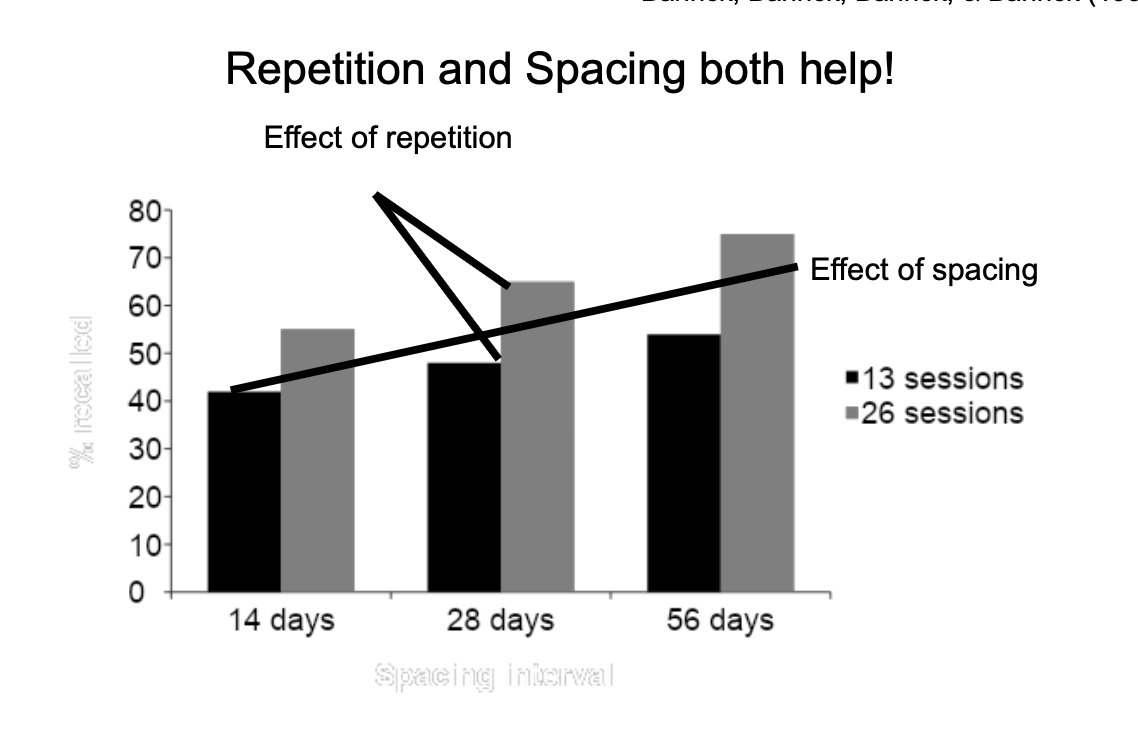
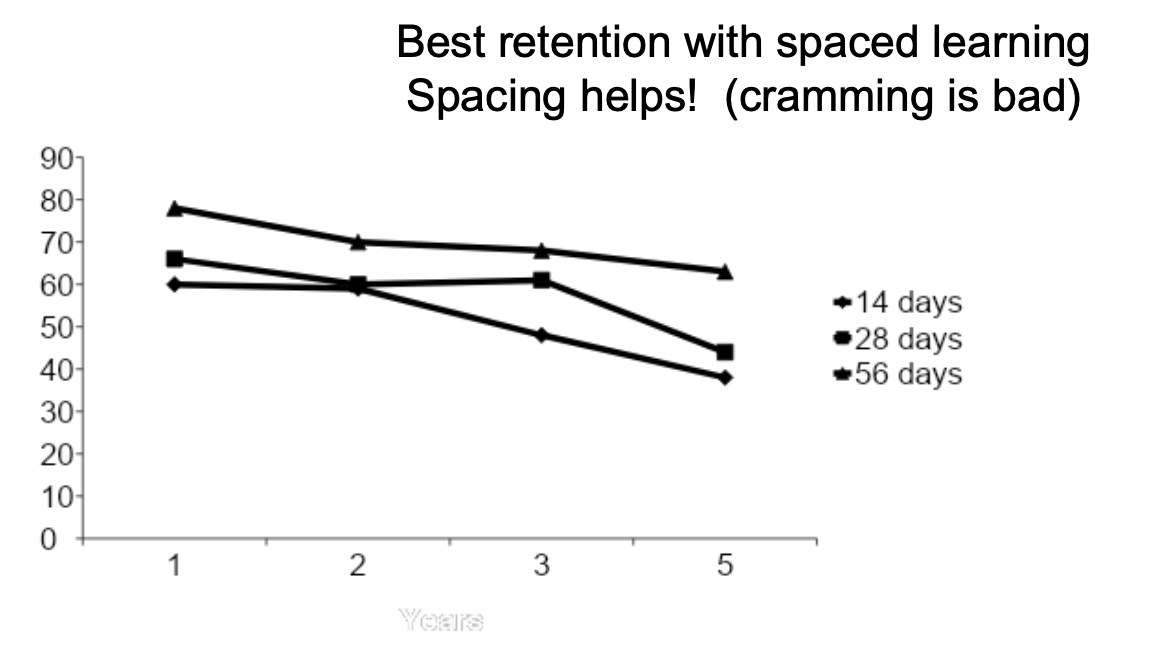
Consolidation
Fragile memories → Permanent Memories
more of a destination already rather than needing the map
Synaptic – rapidly over minutes
Systems – slow reorganization of circuits within brain regions
Brain activity during consolidation
Subsequent Memory Paradigm—Wagner, Schacter, Rotte, Koutstaal, Maril, Dale, Rosen, & Buckner (1998)*
Measure brain activity during study
making judgements about words, not directly memorizing
recognition test essentially
experimenters sorted what they remembered and didnt remember then record brain activity for each respectively
brain activity is lower when you forget, but it’s happening during encoding
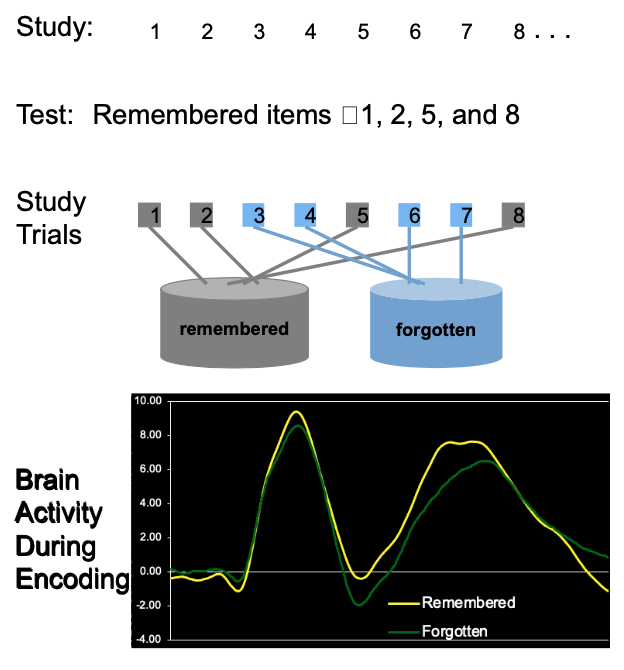
it’s about encoding it well
fMRI activity:
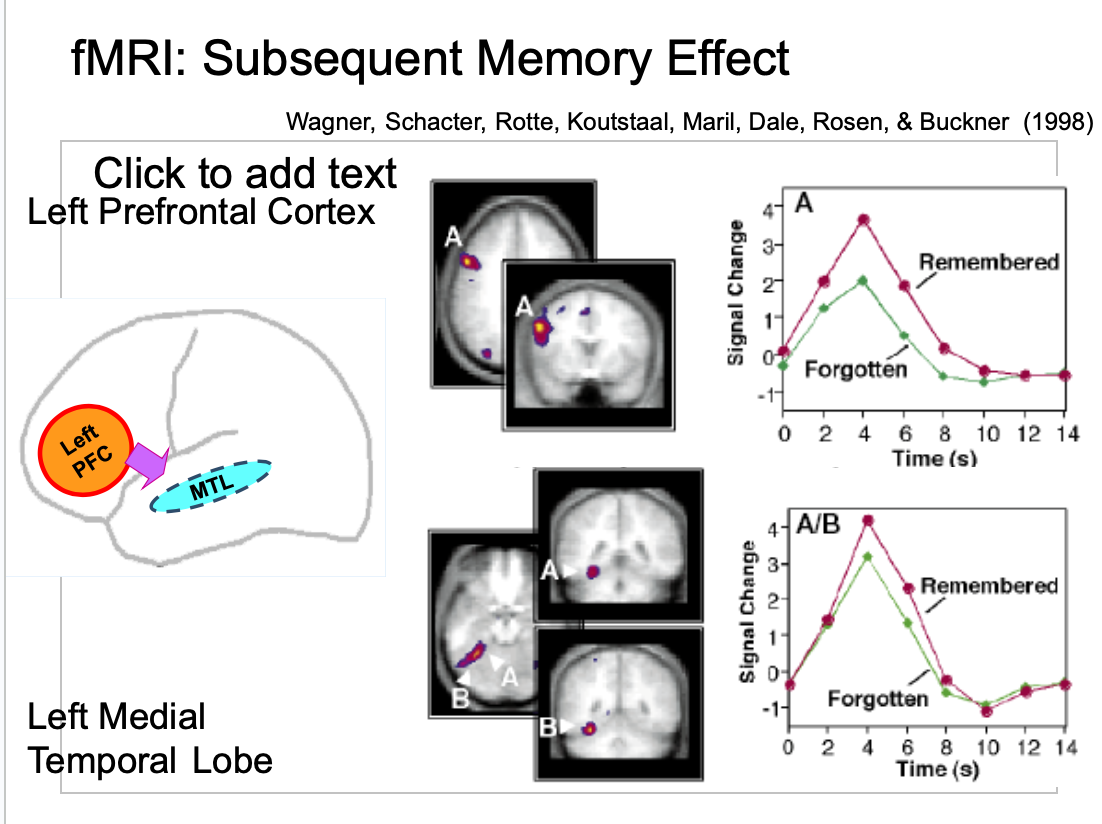
Memory differences
Syesthesia—Palmeri, Blake, Marois, Flanery, & Whetsell (2002)
visual search task to find T in group of Ls
more Ls, the harder it is
synesthetes see each letter iwth a different color, then they’re able to find it easier

The Brains of Memory Champions—Maguire, Valentine, Wilding, & Kapur (2003)
world memory champs > brain activity in the hippocampus and other brain regions important for visaul-spatial imagery
use visual-imagery to structure their memory
Extraordinary Memory: AJ—Parker, Cahill, & McGaugh (2006)
asked to recall on a given day and she would be able to remember the entire day
journaled a lot in her youth
compared journal to recall and she was correct
hyperthymesia: near perfect autobiographical memory
not photographic memory, only personal memories
Patient H.M—Corkin (2002)
History
epilepsy started at age 10
severe seizures in late 20s affecting quality of life
surgery to correct
W. B. Scoville
bilateral temporal lobectomy
removed the hippocampus
After surgery
Seizures reduced
Intelligence increased (as result of reduction in seizure activity)
Short-Term/Working memory OK
Anterograde Amnesia— couldn’t make new longterm memories
One of the first cases on the role tht the hippocampus has in memory
Clive Wearing (anterograde amnesia)
Cause of amnesia → herpes encephalitis
damage to hippocampus
Preserved cognitive abilities
Intelligence
skills like playing piano and conducting
Is all memory impaired in anterograde memory—Milner, Squire, & Kandel (1998); Milner (1962)
Anterograde amnesia
ok short term memory
impaired declarative memory
Non-declatarive memory??? (skill-learning)
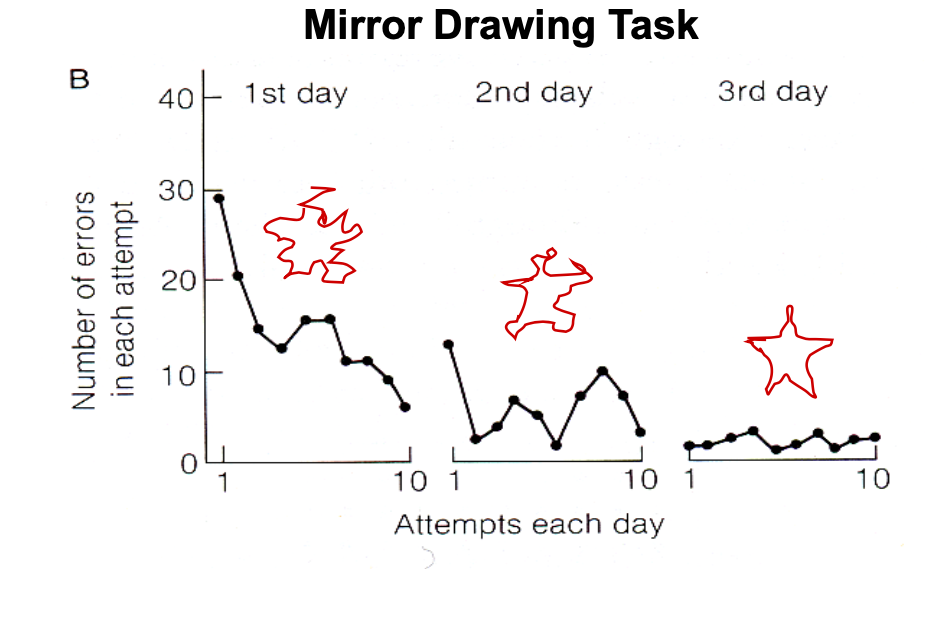
HM’s task performance for mirror drawing task^
he improved day after day, even though he had no recolection of learning it
does not have declarative memory, but has new non-declarative memory
Anterograde amnesia: cannot form new explicit memory, but can form new implicit memory
Patient M.L. (retrograde amnesia)—Levine, Black, Cabeza, Sinden, McIntosh, Toth, Tulving, & Stuss (1998)
Had damage in right frontal lobe
Could learn about events prior to the accident
can form new memories about their old memories, but don’t have the eposodic memory to remember it on their own
But no longer re-experience them as being part of his own life
Preserved semantic memory for information prior to accident
Impaired episodic memory for events prior to accident
Retrograde amnesia is specific to episodic memory
Patient K.C.—endel tulving
Damage to Many Brain Regions: due to motorcycle accident
Medial temporal, frontal, parietal, & occipital lobes
Normal:
IQ (94)
Can acquire nondeclarative memories
skills etc
Semantic memory for events prior to injury
facts et
Anterograde Amnesia AND Retrograde Amnesia for Episodic Memory
no new declarative memories and no pror episodic memory
If shown pic of family— could remember each family member, but couldn’t remember why they were dressed a certain way
4 out of 5 on a scale of happiness
When asked how long he wanted to live, his response was, “I guess 100 would be good,” Tulving recalls.
Anterograde Amnesia
Can not form new declarative memories
Can form new nondeclarative memories
Damage to Medial Temporal Lobes (hippocampus)
Retrograde Amnesia
Can not recall old memories, especially episodic memories
Damage to brain regions outside of the Hippocampus
Anterograde Amnesia
Can not form new declarative memories
Can form new nondeclarative memories
Damage to Medial Temporal Lobes (hippocampus)
Retrograde Amnesia
Can not recall old memories, especially episodic memories
Damage to brain regions outside of the Hippocampus
Summary: Memory Disorders
Anterograde Amnesia
Can not form new declarative memories
Can form new nondeclarative memories
Damage to Medial Temporal Lobes (hippocampus)
Retrograde Amnesia
Can not recall old memories, especially episodic memories
Damage to brain regions outside of the Hippocampus
Everyday Memory problems
Schemas: generalized outlines of typical scenarios
ex. we have a schema for eating at. a restaurant
Costs and Benefits of Schemas
Pros:
Provides framework within which to remember an event
‘chunking’ since don’t have to remember all details
Cons
Can lead to misremembering a specific event via generalizations or confusion
naming things you think would be there bc they’re expected
Deese-Roediger-McDermott Paradigm—Roediger & McDermott (1995)
gave people list of words that were related and tried to remember them
list of words were always related to one central word as theme
Results:
people were good at memorizing the words they asked
critical loure —word that the others were designed around, but not explicitly on list
people remember middle word abt 40% of the time
We remember general knowledge and the ‘gist’ of an event and not always the specifics
Usually helps, but can also hurt
return to Car Crash study—Loftus & Palmer (1974)
Design:
Subjects watched car accident & asked how fast cars were going when HIT or SMASHED into each other
Hit — 34 mph
Smashed = 41 mph
One week later:
Was there any broken glass? (there wasn’t)
hit - 14% yes
smashed -32% yes
/
False Memories
Processes involved in recalling real memories are the same ones responsible for false memories
Reality Monitoring:
judging whether something you’re recalling is real or imaginary
real memories tend to have more perceptual details than false ones
memories of imagined events have lesser detail, and have more emotional states
Source Monitoring: ***
remembering where you learned something ‘did I dream it?’
unsure of where you learned it or if it happened to you or not
Methods—(Lyle and Johnson) 2006
has people look at different screens,
either saw a word or a word AND a drawing
word: imagine word image
drawing: just look at drawing
Manipulated by putting things that are either related or unrelated to each other
lollipop looks like magnifying class
heart does not look like mug
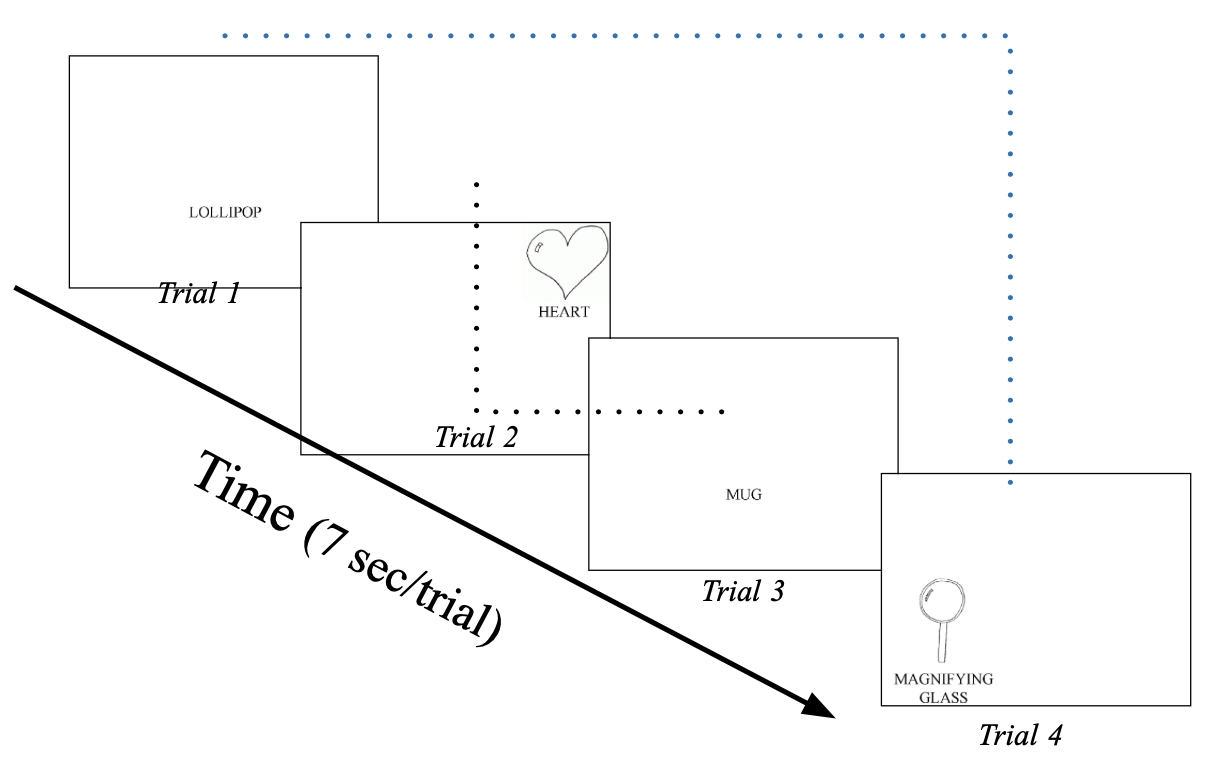
results
control and similar most important
control: ask about items you did not see but imagined you saw
Similar: ask about things that you saw that look similar to the imagined image you saw
Asking that you saw something similar to what you imagined created false memories
Explanation
test similar items —> reactivate: imagined shapte info + seen shape info from similar pic (imported details)
Test control items —> Reactivsyte imagined shape info
Appearance Vividness (given false memory)—Lyle & Johnson (2006)
Seen = true memories
evidence that reality monitoring uses vividness to help remember if the memory is real or not
Lost-in-the-mall study—(Loftus & Pickrell (1995)
Provide college students with 4 events from their past
1 of these events was false (being lost in the mall as a child)
talked to parents to make sure at least 3 events actually happened
asked to write down everything they know about their events
did it again after 2 weeks
did it after 2 weeks again
25% of people remembered false event by end of the study.
Just by asking people over and over again about something that happened, that didnt, they can convince themselves that it did happend
Hot air balloon—Wade, Garry, Read, & Lindsay (2002)
Shown doctored photo
Recall event, recall 3 to 7 days later, recall again 3 to 7 days later
0% of subjects didn;t temember initially
35% recalled
50% recalled being on a hot air balloon
Also highlights importance of visual
Elementary school trouble —Lindsay, Hagen, Read, Wade, & Garry (2004)
Recall events from elementary school, including fake event
Manipulate presentation of school photo
here is your class photo of x grade
‘tell me everything you can remember about getting in trouble for this at school”
How does photo help/hurt creating flase memory
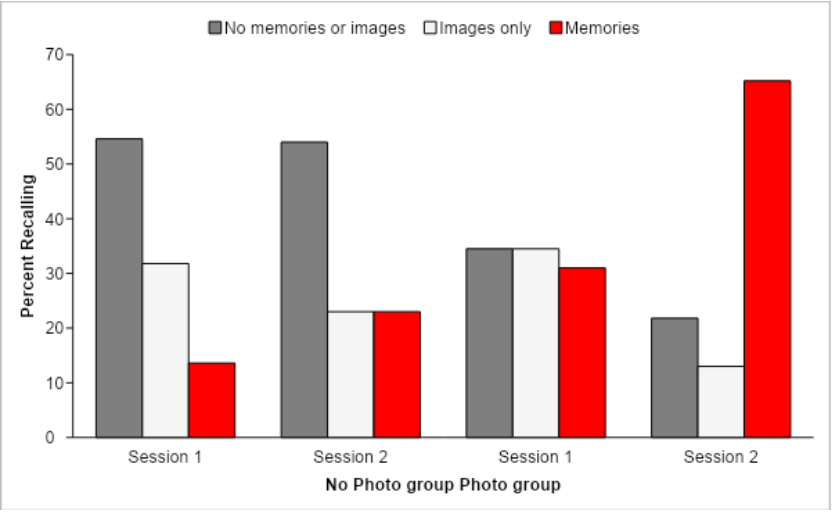
visual images can start being incorporated and help to build up false memories over time
Real life to lab translation—Clancy, McNally, Schacter, Lenzenweger, & Pitman (2002)
Are people who have some type of false memory more likely to have false memories more generally?
tested people who think they had something happen to them that didnt happen —> alien abduction
Conditions
Recovered- memory where they can tell you detailed play-by-play of event
Repressed - believe they were abducted, but don’t have any strong detailed memory about event
Control- dont claim to be abducted by aliens
Gave them DRN paradigm (all words were related to one key word as theme— critical loures)
were more likely to remember loures that were unrelated to the main critical loure
we have a schema of what the alien should look like, so the false memory is created around the schema
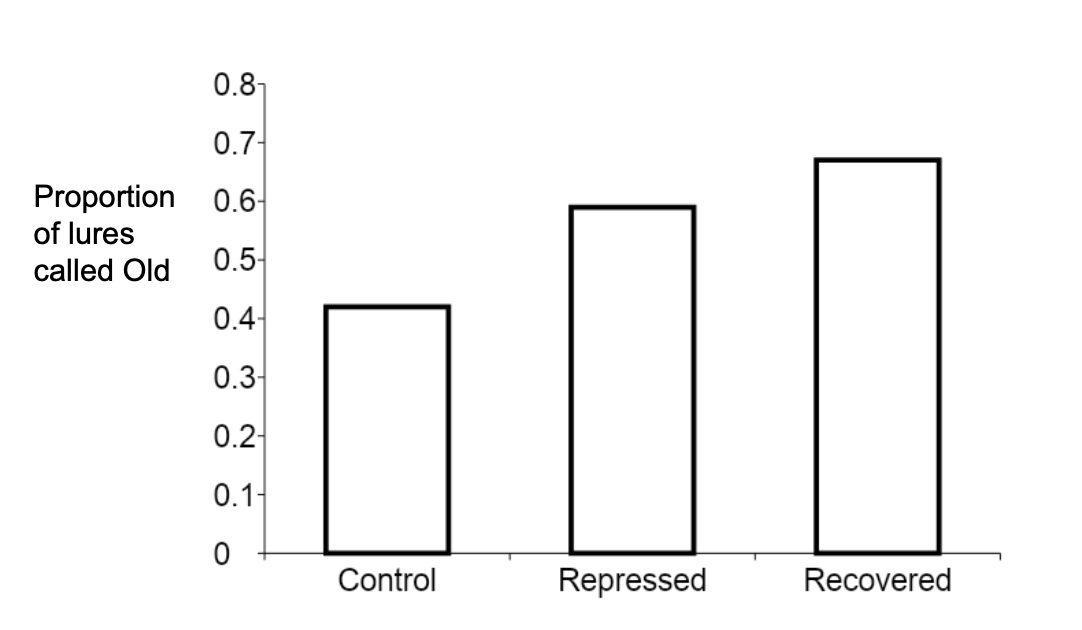
Flashbulb memories—Brown & Kulik (1977)
Main claim: Emotional and Significant events are remembered perfectly
Special events lead to prioritized memories
Very accurate
Immune to forgetting
Vivid
Typical Knowledge with Flashbulb Memories
Where you were
Who you were with
What you were doing
How you found out
What you were wearing
How you felt
Evidence Against Flashbulbs—Talarico & Rubin (2003)
Sept 12th, 2001
54 students asked about their memories of 9/11 and of (everyday) events from that week
Tested 1, 6, or 32 weeks later
Rated accuracy, vividness, & confidence
Result: Confidence remains high but accuracy does not!
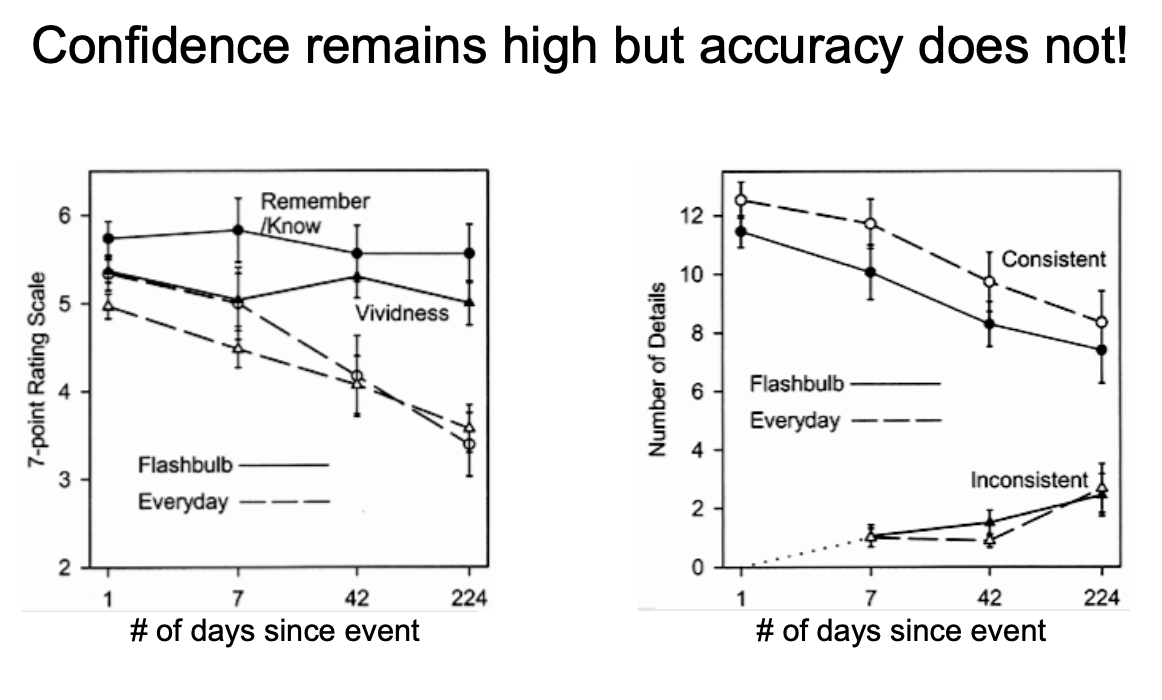
Memory studies
Facets of memory
Memory is Malleable—Loftus & Palmer (1974)\
About how fast was the car going when it ________ the stopped car?
the wording of the question influenced the memory
Misconceptions of Memory: The Scooter Libby Effect—Kassam, Gilbert, Swencionis, & Wilson (2009)
Vice-Presidential Chief of Staff I. Lewis “Scooter” Libby claimed that he could not remember mentioning the identity of a Central Intelligence Agency employee to other government officials or reporters. Jurors found it difficult to believe that Libby could have forgotten having had such important conversations and found him guilty of obstruction of justice, making false statements, and perjury.
motivation to remember (MTR)
Participants were shown photographs of six individuals ostensibly taken from a high-school yearbook. Each photograph was accompanied by five facts (e.g., “John Smith enjoyed playing sports with his friends” or “Sarah Palmer spent a lot of time tutoring her younger brother”).
Memorizers were told that they would study the material for 2 min before seeing the photographs and trying to recall the facts associated with each. They were also told that they would receive $0.10 for each recalled fact.
Judges were shown the same material as memorizers and read a detailed description of the instructions from the MTR-at-encoding condition (n = 24), the MTR-at-retrieval condition (n = 21), or the no-MTR condition (n = 21). Judges were then asked to predict the percentage of memorizers in that condition who would remember each fact.
Our study shows that people mistakenly expect MTR to be just as effective when it arises after information is encountered as when it arises beforehand. Thus, they sometimes expect others to remember more than they possibly can.
The study found that memorizers recalled more facts when motivated before reading than after, with post-reading motivation no better than no motivation. However, judges incorrectly expected both pre- and post-reading motivation to enhance memory equally and outperformed no motivation. This reveals a gap between actual memory performance and judges' expectations.

Memory works in ways we don’t realize—Simons & Chabris (2011)
This discrepancy between popular belief and scientific consensus has implications from the classroom to the courtroom.
Amnesia results in the inability to remember one's own identity (83% of respondents agreed), unexpected objects generally grab attention (78%), memory works like a video camera (63%), memory can be enhanced through hypnosis (55%), memory is permanent (48%), and the testimony of a single confident eyewitness should be enough to convict a criminal defendant (37%

Models of Memory

Modal Model of Memory—Atkinson & Shiffrin (1968)
Memory has 3 components
sensory memory— iconic, echoic, haptic
working memory / short-term memory— capacity for holding a small amt of info for a short period of time
7 ± 2
20-30 sec
long-term memory

Sensory Memory
In each trial:
Read a 3-letter string (e.g., TRQ)
Read a 3-digit number (e.g., 555)
Count backwards by threes (silently)
E.g., for 555, count 552, 549, 546…
When the word “stop” appears 🡪 write down the 3-letters
Look to the left column to read the next string
Classic Test of Sensory Memory (Iconic)—Sperling (1960)
participants were briefly shown a grid of 12 letters for 50 milliseconds then were asked to recall as many letters as they could
could initially only remember 3-4 letters
then changed conditions to be high, medium, then low tone for each row
participants could remember all of them after



Hierarchical Structure of Semantic Networks, Collins & Quillian (1969)

“is an eggplant food/fruit/rggplant”
looked at speed, as you move up the hierarchy speed of answer slows down

ex. talking about something that is related to something that someone else brought up, moving up the semantic bridge
the more connections you have, the more you’ve woven it into the semantic network, the more activation of the network
Working Memory— primacy and recency
What causes Primacy & Recency Effects?
Primacy – Extended rehearsal moves info to long-term memory
longterm interferes with working
Recency – Recent rehearsal keeps info in working memory at test
short term/working intereferes with long term
Primacy and Recency Effects reveal different operations involved with Working Memory


Baddeley’s Model of Working Memory—Baddeley (1974)
phonological loop—auditory part of working memory; being used when saying things to yourself or listening to others
evidence: Working memory affected by Word Length
evidence: Working memory affected by Reading Speed
evidence: Working memory affected by Language
visuospatial sketch pad—picture things in working memory and work on them
mental maps etc
episodic buffer— part of working memory that temporarily stores info brought up from long-term memory
central executive— controls how attention to paid to each of other parts of working memory, brings info from long-term memory, and puts things together

Object-based Working Memory (how is info stored in visuospatial sketchpad?) —Luck & Vogel (1997)
Main Claims
Visual information stored as objects
Limit of about 3-4 objects
If you remember one feature of an object, you get all the other features for free
Change Detection Paradigm:
The study used a change detection paradigm where participants viewed a set of objects with different features (like color and shape) and then had to identify if a single feature on one of the objects had changed in a subsequent display.
found No change in accuracy for 3-4 objects (remembered them fine, but more than that found a decrease in performance) —>limited

Conjunctions
Remember Orientation (ignore color)
Remember Color (ignore orientation)
Remember Orientation & Color
Findings: Consistent with object-based! —> features don’t matter, just how many there are as integrated objects (culmination of features)
Object Benefit:
The key finding was that participants were able to accurately detect changes in a set of objects with multiple features, even when the number of features increased, as long as those features belonged to the same object. This "object benefit" indicated that the brain stores objects as unified entities rather than individual features.
Implications:
This research significantly contributed to the understanding of visual working memory, suggesting that the capacity of visual working memory is not limited by the number of individual features but rather by the number of distinct objects that can be held in memory
Potential problems with object based working memory— Alvarez & Cavanagh (2004)
, both the visual information load and number of objects impose capacity limits on visual short-term memory.
The greater the information load of each item in a stimulus class (as indicated by a slower search rate), the fewer items from that class one can hold in memory.
Extrapolating this linear relationship reveals that there is also an upper bound on capacity of approximately four or five objects.
Updated model of Baddledy’s model

Memory processes
Interference
Proactive Interference: An item you learned previously affects something you’re trying to recall recently
Retroactive Interference: learning something after the first interferes with recalling the initial information
Interference shows that putting new things into long-term memory affects other things that are there, and vice versa.
General point that our memories are connected.
the more similar the contents are, the greater chance of interference
Encoding and retrieval
Encoding: Acquiring information and transferring it into LTM
retrieval: Recovering previously encoded information
the more organized your encoding structure, the better you’ll remember it
Elaboration: Making additions to the target item
makes connections in semantic memory
E.g., remember “table”
Tables are types of furniture
Furniture is very expensive
I buy furniture in IKEA because it is more reasonably priced
Last year I bought a great table in IKEA
Depth of processing Craik & Tulving (1975)
Orthographic: what does the word look like (capital/lowercase)
Phonological: how does the word sound
Semantic: what is the meaning of the word
the deeper you process it initially, the better you remember it
Elaboration

Location dependent memory—Godden & Baddeley (1975)
group of subjects in a pool or on land in scuba gear
reading them a list of words that they need to learn either on land or in water
Half recall on land, half recall in water
learned on land recalled better on land
learned underwater recalled better on land

Emotion Dependent Memory—Bower (1981)
induced emotion to be happy or sad
then learned a list of words
then made them recall a list of words and asked if it made them happy or sad
if youre happy when you learn and happy when you retrieve, then you remember more

State Dependent Memory—Rickles, Cohen, Whitaker, & McIntyre (1973)
needed multiple trials with marijuana
when you learn intoxicated, you’re better at recalling when you’re intoxicated

Effects of Spacing on Memory—Bahrick, Bahrick, Bahrick, & Bahrick (1993)*
gave subjects foreign language words, and had no relation
tested retention of foreign language of fpreign language vocabulati words
After Learning, tested 1, 2, 3, & 5 years later

long term implications
Findings: best retentions comes with spacing learning
more times more recall
more space had a better recall


Consolidation
Fragile memories → Permanent Memories
more of a destination already rather than needing the map
Synaptic – rapidly over minutes
Systems – slow reorganization of circuits within brain regions
Brain activity during consolidation
Subsequent Memory Paradigm—Wagner, Schacter, Rotte, Koutstaal, Maril, Dale, Rosen, & Buckner (1998)*
Measure brain activity during study
making judgements about words, not directly memorizing
recognition test essentially
experimenters sorted what they remembered and didnt remember then record brain activity for each respectively
brain activity is lower when you forget, but it’s happening during encoding

it’s about encoding it well
fMRI activity:

Memory differences
Syesthesia—Palmeri, Blake, Marois, Flanery, & Whetsell (2002)
visual search task to find T in group of Ls
more Ls, the harder it is
synesthetes see each letter iwth a different color, then they’re able to find it easier

The Brains of Memory Champions—Maguire, Valentine, Wilding, & Kapur (2003)
world memory champs > brain activity in the hippocampus and other brain regions important for visaul-spatial imagery
use visual-imagery to structure their memory
Extraordinary Memory: AJ—Parker, Cahill, & McGaugh (2006)
asked to recall on a given day and she would be able to remember the entire day
journaled a lot in her youth
compared journal to recall and she was correct
hyperthymesia: near perfect autobiographical memory
not photographic memory, only personal memories
Patient H.M—Corkin (2002)
History
epilepsy started at age 10
severe seizures in late 20s affecting quality of life
surgery to correct
W. B. Scoville
bilateral temporal lobectomy
removed the hippocampus
After surgery
Seizures reduced
Intelligence increased (as result of reduction in seizure activity)
Short-Term/Working memory OK
Anterograde Amnesia— couldn’t make new longterm memories
One of the first cases on the role tht the hippocampus has in memory
Clive Wearing (anterograde amnesia)
Cause of amnesia → herpes encephalitis
damage to hippocampus
Preserved cognitive abilities
Intelligence
skills like playing piano and conducting
Is all memory impaired in anterograde memory—Milner, Squire, & Kandel (1998); Milner (1962)
Anterograde amnesia
ok short term memory
impaired declarative memory
Non-declatarive memory??? (skill-learning)

HM’s task performance for mirror drawing task^
he improved day after day, even though he had no recolection of learning it
does not have declarative memory, but has new non-declarative memory
Anterograde amnesia: cannot form new explicit memory, but can form new implicit memory
Patient M.L. (retrograde amnesia)—Levine, Black, Cabeza, Sinden, McIntosh, Toth, Tulving, & Stuss (1998)
Had damage in right frontal lobe
Could learn about events prior to the accident
can form new memories about their old memories, but don’t have the eposodic memory to remember it on their own
But no longer re-experience them as being part of his own life
Preserved semantic memory for information prior to accident
Impaired episodic memory for events prior to accident
Retrograde amnesia is specific to episodic memory
Patient K.C.—endel tulving
Damage to Many Brain Regions: due to motorcycle accident
Medial temporal, frontal, parietal, & occipital lobes
Normal:
IQ (94)
Can acquire nondeclarative memories
skills etc
Semantic memory for events prior to injury
facts et
Anterograde Amnesia AND Retrograde Amnesia for Episodic Memory
no new declarative memories and no pror episodic memory
If shown pic of family— could remember each family member, but couldn’t remember why they were dressed a certain way
4 out of 5 on a scale of happiness
When asked how long he wanted to live, his response was, “I guess 100 would be good,” Tulving recalls.
Anterograde Amnesia
Can not form new declarative memories
Can form new nondeclarative memories
Damage to Medial Temporal Lobes (hippocampus)
Retrograde Amnesia
Can not recall old memories, especially episodic memories
Damage to brain regions outside of the Hippocampus
Anterograde Amnesia
Can not form new declarative memories
Can form new nondeclarative memories
Damage to Medial Temporal Lobes (hippocampus)
Retrograde Amnesia
Can not recall old memories, especially episodic memories
Damage to brain regions outside of the Hippocampus
Summary: Memory Disorders
Anterograde Amnesia
Can not form new declarative memories
Can form new nondeclarative memories
Damage to Medial Temporal Lobes (hippocampus)
Retrograde Amnesia
Can not recall old memories, especially episodic memories
Damage to brain regions outside of the Hippocampus
Everyday Memory problems
Schemas: generalized outlines of typical scenarios
ex. we have a schema for eating at. a restaurant
Costs and Benefits of Schemas
Pros:
Provides framework within which to remember an event
‘chunking’ since don’t have to remember all details
Cons
Can lead to misremembering a specific event via generalizations or confusion
naming things you think would be there bc they’re expected
Deese-Roediger-McDermott Paradigm—Roediger & McDermott (1995)
gave people list of words that were related and tried to remember them
list of words were always related to one central word as theme
Results:
people were good at memorizing the words they asked
critical loure —word that the others were designed around, but not explicitly on list
people remember middle word abt 40% of the time
We remember general knowledge and the ‘gist’ of an event and not always the specifics
Usually helps, but can also hurt
return to Car Crash study—Loftus & Palmer (1974)
Design:
Subjects watched car accident & asked how fast cars were going when HIT or SMASHED into each other
Hit — 34 mph
Smashed = 41 mph
One week later:
Was there any broken glass? (there wasn’t)
hit - 14% yes
smashed -32% yes
/
False Memories
Processes involved in recalling real memories are the same ones responsible for false memories
Reality Monitoring:
judging whether something you’re recalling is real or imaginary
real memories tend to have more perceptual details than false ones
memories of imagined events have lesser detail, and have more emotional states
Source Monitoring: ***
remembering where you learned something ‘did I dream it?’
unsure of where you learned it or if it happened to you or not
Methods—(Lyle and Johnson) 2006
has people look at different screens,
either saw a word or a word AND a drawing
word: imagine word image
drawing: just look at drawing
Manipulated by putting things that are either related or unrelated to each other
lollipop looks like magnifying class
heart does not look like mug

results
control and similar most important
control: ask about items you did not see but imagined you saw
Similar: ask about things that you saw that look similar to the imagined image you saw
Asking that you saw something similar to what you imagined created false memories
Explanation
test similar items —> reactivate: imagined shapte info + seen shape info from similar pic (imported details)
Test control items —> Reactivsyte imagined shape info
Appearance Vividness (given false memory)—Lyle & Johnson (2006)
Seen = true memories
evidence that reality monitoring uses vividness to help remember if the memory is real or not
Lost-in-the-mall study—(Loftus & Pickrell (1995)
Provide college students with 4 events from their past
1 of these events was false (being lost in the mall as a child)
talked to parents to make sure at least 3 events actually happened
asked to write down everything they know about their events
did it again after 2 weeks
did it after 2 weeks again
25% of people remembered false event by end of the study.
Just by asking people over and over again about something that happened, that didnt, they can convince themselves that it did happend
Hot air balloon—Wade, Garry, Read, & Lindsay (2002)
Shown doctored photo
Recall event, recall 3 to 7 days later, recall again 3 to 7 days later
0% of subjects didn;t temember initially
35% recalled
50% recalled being on a hot air balloon
Also highlights importance of visual
Elementary school trouble —Lindsay, Hagen, Read, Wade, & Garry (2004)
Recall events from elementary school, including fake event
Manipulate presentation of school photo
here is your class photo of x grade
‘tell me everything you can remember about getting in trouble for this at school”
How does photo help/hurt creating flase memory

visual images can start being incorporated and help to build up false memories over time
Real life to lab translation—Clancy, McNally, Schacter, Lenzenweger, & Pitman (2002)
Are people who have some type of false memory more likely to have false memories more generally?
tested people who think they had something happen to them that didnt happen —> alien abduction
Conditions
Recovered- memory where they can tell you detailed play-by-play of event
Repressed - believe they were abducted, but don’t have any strong detailed memory about event
Control- dont claim to be abducted by aliens
Gave them DRN paradigm (all words were related to one key word as theme— critical loures)
were more likely to remember loures that were unrelated to the main critical loure
we have a schema of what the alien should look like, so the false memory is created around the schema

Flashbulb memories—Brown & Kulik (1977)
Main claim: Emotional and Significant events are remembered perfectly
Special events lead to prioritized memories
Very accurate
Immune to forgetting
Vivid
Typical Knowledge with Flashbulb Memories
Where you were
Who you were with
What you were doing
How you found out
What you were wearing
How you felt
Evidence Against Flashbulbs—Talarico & Rubin (2003)
Sept 12th, 2001
54 students asked about their memories of 9/11 and of (everyday) events from that week
Tested 1, 6, or 32 weeks later
Rated accuracy, vividness, & confidence
Result: Confidence remains high but accuracy does not!
